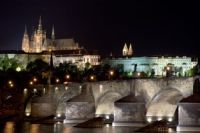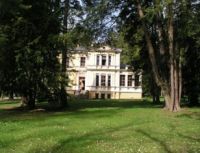The arts play a
vital role in troubled times, a fact happily demonstrated by the
Kentucky Symphony Orchestra Saturday night in Greaves Concert Hall at
Northern Kentucky University.
"WIth all the dissonance and
crassness in our world today, we need a little melody and harmony,"
said KSO music director James R. Cassidy.
Where better to find it than in the music of 19th and 20th-century Bohemia?
The program, dubbed "Czech, Please," featured music by Smetana, Janacek, Dvorak and Jan Vaclav Vorisek. It had a visual component, too: 230 PowerPoint images from the Czech Republic, painstaking selected and correlated with the musical scores by Cassidy.
None of this was
intrusive. The pictures, gathered from numerous sources, including
former KSO violist Mark Newkirk who now lives in the Czech Republic,
were displayed on four small plasma screens mounted on either side of
the hall. There were ravishing views of the Czech countryside, folk
festivals, villages and majestic Prague. Manning the Mac PowerBook controls
was KSO volunteer Don Miles.

As expected on any KSO concert,
there was a surprise, Vorisek's 1823 Sinfonia in D Major, lone
symphonic work by a promising young Czech who was just taking wing
within the circle of Beethoven and Schubert in Vienna before dying at
34. It is a neglected gem. Beethoven was "the man" when Vorisek wrote
it and, like Beethoven, it anticipates romanticism, especially in the
dark-hued Andante, which Cassidy keyed to wintry scenes, including
headstones in a cemetery, culminating in an extraordinary sunset
filtering through the branches of a large tree.
The outer
movements, both Allegro con brio, recall Haydn, the scurrying finale
referenced to scenes of folk dancing, marionettes, etc. The third
movement was a vigorous scherzo with a charming trio. Performed with a
reduced KSO -- 22 strings with double winds, horns and trumpets, plus
timpani -- it could have been tidier in spots and, as in Haydn and
Mozart, was "like performing in your underwear" (as Cassidy told his
players).
A suite from Janacek's 1924 opera "The Cunning Little
Vixen" capped the first half. That's "vixen" as in fox, and the opera
is an anthropomorphic tale about coming of age, lost opportunities
(mostly about love) and the cycle of nature. The KSO took flight here
on some soaring music, and there was fine solo work by concertmistress
Manami White, harpist Li-Ya Huang, violist Lucy Firlie Ginther and
flutist Susan Magg, among others. The images were correlated with a
stage director's eye, with lots of flora and fauna -- including badger,
frog, insects and foxes, all characters in the opera – and in the first
movement, images depicting a day in the woods, from glowing sunrise to
indigo-blue nightfall.
The grand finale was Dvorak's Symphony
No. 8, a work suffused with the musical language of his country. String
sound was lush and full, and the winds and brass played with tonal
polish and precision. There was a breathtaking moment in the slow
movement (Adagio) where a majestic climax gave way to a sudden, soft
echo. The folklike variations in the finale had great personality, and
Cassidy delivered the energetic conclusion with a flourish.

Smetana's Overture to "The Bartered Bride," which opened the concert,
had plenty of spirit, but the taxing string passages were sometimes
ragged.
The concert repeats at 3 p.m. Sunday in Greaves Hall.
(first published in The Cincinnati Enquirer April 6, 2009)
